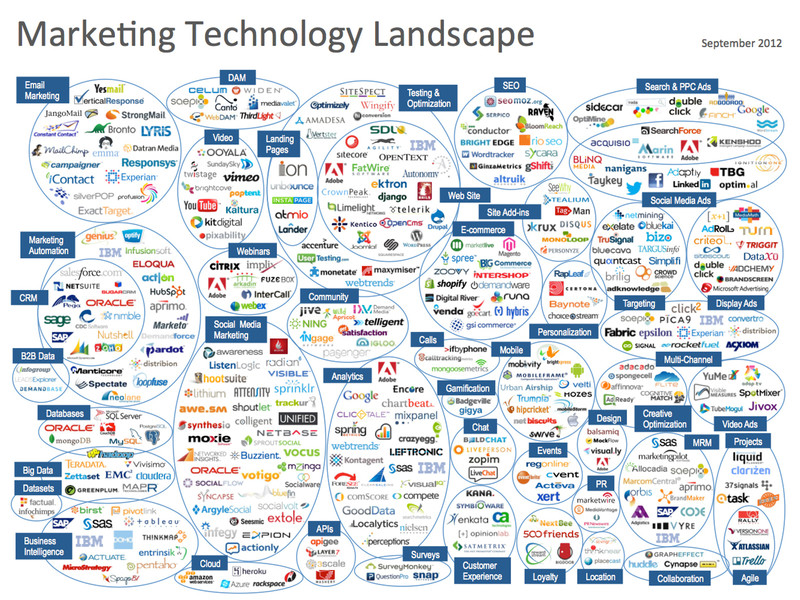Walking in the shoes of a modern marketer
Due to advancements in technology, marketers are now finding themselves at a crossroads of marketing, technology and customer success. Big data (aka The New Oil) has changed the dynamics and priorities of the marketing team. This data-driven landscape is also encouraging companies to use more tailored technology to uncover actionable insights. However, this level of sophistication sets up new challenges for the modern marketer. They need to be able to successfully manage the marketing stack in order to connect the dots between technical advancements and strategic opportunities. Marketing technology stack and its challenges A marketing technology stack is a mix of technologies that marketers use to run and optimise their marketing/sales activities. Most teams today use at least a small selection of these core platforms:
- CMS (including Drupal, WordPress, Magento, Joomla, etc.)
- Analytics (Google Analytics, Webmaster tools, Kissmetrics, Crazy Egg, etc.)
- CRM (Oracle CRM, SAP, Salesforce, Microsoft Dynamics, SugarCRM, etc.)
- Marketing automation (Eloqua, Pardot, HubSpot, Marketo, etc.)
- Paid media and ad tech (DoubleClick, Bing, AdWords, RocketFuel, Marin, etc.)
- Social media (LinkedIn, Twitter, Facebook, etc.)
According to Ghostery, the average company deploys more than 35 vendor technologies. So what does this mean for marketing teams? Having access to leading-edge technology means opportunities, but it also means complexity. With so many choices, it’s easy to spread efforts across a large spectrum of software without getting the desired results. For this reason, it’s essential to have a clear understanding of how technology can help achieve the business goals.
Here are 3 recommended steps that will help uncover what could be the right marketing technology stack for your team:
- Define the MarTech Strategy [and challenges]
Determine business value, list your goals and evaluate the technology already in place. Defining the business goals is a key step. Before reviewing and shortlisting a selection of new suppliers, it’s essential to understand how the new technology will help your team drive customer success. Properly planning your goals and what you need to achieve is the core of this process and will guide all the upcoming work. Understanding the team’s challenges and the current usage of existing technologies is another important step of this process. Questions to ask at this stage: is the existing technology supporting your growth plans? If so, how could you use it more effectively and across the board? If the existing technology is not satisfying the current/future needs, how can you add new technology to the stack and align it to your goals and needs?
This approach is mapped out below.
2. Build an Implementation Roadmap Have a defined roadmap to follow.
Implementation is always better off with a clear roadmap agreed by all stakeholders. When adding new technology to your marketing stack it’s also a good time to put in place (or review) processes that will help your team work more efficiently. Here are a few recommended steps to follow when adopting new technologies to the stack.
Focus on addressing the crucial pointers:
- Discovery and planning
A good place to start is talking to your team to understand the current needs and identify the priorities. Based on the in-house intelligence gathered, develop an evaluation framework. Consider putting together a ‘Request For Information’ document, outlining the key requirements, ‘nice to have’ features, deadlines, support, long-term benefits, legal T&C’s, etc. Make time to carry out external research and review technologies that will satisfy your business needs.
- Integrations
Remember, in most cases adding new technology to the stack will require integration with existing systems. Harmonising these siloed technologies and standardising the data definitions across applications should help your team deliver consolidation around data, reports, and ultimately deliver a better experience. Planning the IT resource and reviewing these integrations well in advance will also save you hours of work down the line.
- Training
Training and upskilling is a key aspect when on-boarding new technology. An aspect of the training often overlooked is user adoption. It’s crucial that your team loves the technology they’ll use. To some extent it can be argued that the data, insights and software is as good as the people who are using it.
3. Conduct Internal MarTech Audit
Regularly running audits will help ensure that your team has access to a marketing technology stack that makes life easier, not the other way round. It’s best to work together with your team and end users on this evaluation, to understand what it’s like for your marketing team using these tools on a daily basis. Below is a suggested example of how you could audit your marketing tech stack. This process is focused on taking an inventory of the existing tools and grading them based on predefi ned criteria. This particular example uses a scale from 4 to 10 (ideally you shouldn’t have anything that scores less than 4 in your current stack).
Using this example should help identify areas of improvement and potential gaps. For example, you might discover that you are overpaying for your webinar platform or you need to do a better job at training your team on the CMS.
To Conclude
You can’t drive growth with a marketing technology stack that isn’t working for your business. As well as delivering ROI, the right technology should be a good fit, be secure, and have the flexibility to scale and grow with your goals. Spending time and resource on planning, implementing and integrating a marketing technology stack will help you deliver better customer experiences by fine-tuning content, personalising user journeys, and capturing customer feedback. The modern technology landscape requires a clear, well-planned roadmap for making technologies work better together and providing the value you need.



